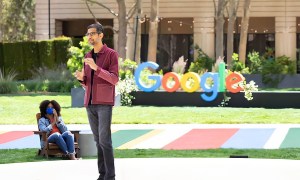

Continuing on the theme that Google is now shifting from a company that helps you find answers to one that helps users get things done, at this year’s I/O developer conference, the company’s focus on the future of Chrome is centered on making the web more instant, more powerful, and safer. With new tools like Portals and Web Packaging, developers can create web experiences with links that feel as seamless and fluid as a native app.
“What makes the web special in today’s landscape is this massive open-scale platform where all of us can freely connect with each other and where new experiences are just a link away,” said Google Director of Engineering Dion Almaer and Senior Director of Product Ben Galbraith during a talk on the future of Chrome at I/O.
Part of improving the web experience is making web pages load faster. To speed up page load times, Google is expanding on Chrome’s pre-load and pre-fetch capabilities this year with a feature called Lazy Loading. Lazy Loading only loads the images that are required by the user. Images toward the bottom of the web page will only load as users continue scrolling, and this new process makes the page load quicker and users can begin interacting on a web page faster. Speed is especially important, as Galbraith explained that just one second in loading time can decrease conversion on a web page by as much as twenty percent. These faster loading pages in essence will allow websites to compete more closely against native apps by delivering fluid experiences that users demand.
Portals and Packaging
To make the web more seamless, Google also introduced a new feature called Portals. “Portals are like iFrames that you can navigate to,” explained Barb Palsar, who leads Google’s global product partnerships. “When a user opens a Portal, the Portal becomes the top-level page. Portal enables fluid, composed journeys within a site or across multiple sites.”
In a demo on stage, Palsar showed that a user can navigate through a website showing recipes. If a user wants to share the recipe, Portals can enable a share sheet to pop up. The share sheet will be the focus of the new view, but the original website is shown blurred and active in the background. Portals can also link other functionality by allowing users to peek into new recipes as they’re scrolling along, similar to how 3D Touch works on iOS today, and connect users to third-party sites, like a grocery store, to add items needed to create the recipe. Portals is now live in Chrome Canary. Because the grocery store access is overlaid through a Portal popup on the main site, completing your order is seamless in that you’re not kicked off one site to complete the task in another site.
Portals are also leveraged in Google’s Duplex for the Web, which was showcased during the main I/O keynote. In a demo, during its Chrome talk, Google demonstrated how an English shopping site can be seamlessly translated into another language — in this case, Hindi — and users will get translations along the e-commerce process.
Google is also changing how websites are packaged. Traditionally, a site has to request the content from an origin server. In the new model, developers create a package with a signed version of the page, and the site can load that signed package from anywhere, including other peer devices. This will boost web page loading speed because the data needed to fetch the package doesn’t need to go back to the origin server. Like Portals, the new Web Packaging is now available in Chrome Canary.
“We believe when you’re looking at Web Packaging and Portals Standards, they have potential over time to enable a more seamless and instant web, with Packaging enabling privacy-safe preloading and Portals enabling seamless transitions,” Galbraith said.
Security and privacy

Similar to what Apple introduced with Safari on MacOS Mojave, Chrome will work to limit tracking on the web. Whereas Safari shows a generic profile to websites that you’re visiting to limit identifiable hardware information used by sites to identify you, Google announced that Chrome will block fingerprinting all together. Though details weren’t available about this process at I/O, Galbraith said that more details will be available in the coming months.
Additionally, moving forward, access to cookies will be limited to first parties, preventing third-parties from snooping on you. Developers will also have to build in code if they want to make cookies visible to third parties, and Chrome will require that cookies shared with third parties be handled over a secure HTTPS connection.
Journey to web app

As the internet proceeds to feel faster and links inside a page feel more seamless, the web experience will start to feel more like a native app. Google demonstrated this with Stadia, its game-streaming platform, by showing full access to a keyboard and mouse with low latency.
But for users who want a more app-like feel, Chrome 76 will start showing installation prompts in the omnibox whenever you visit a site where a web app is available. Google demonstrated that visiting Hulu will show a prompt to download a web app. The process is not unlike how visiting a website on a mobile device will sometimes notify and prompt you to download the corresponding native app if there is one available.
To learn more, developers can visit web.dev today.

